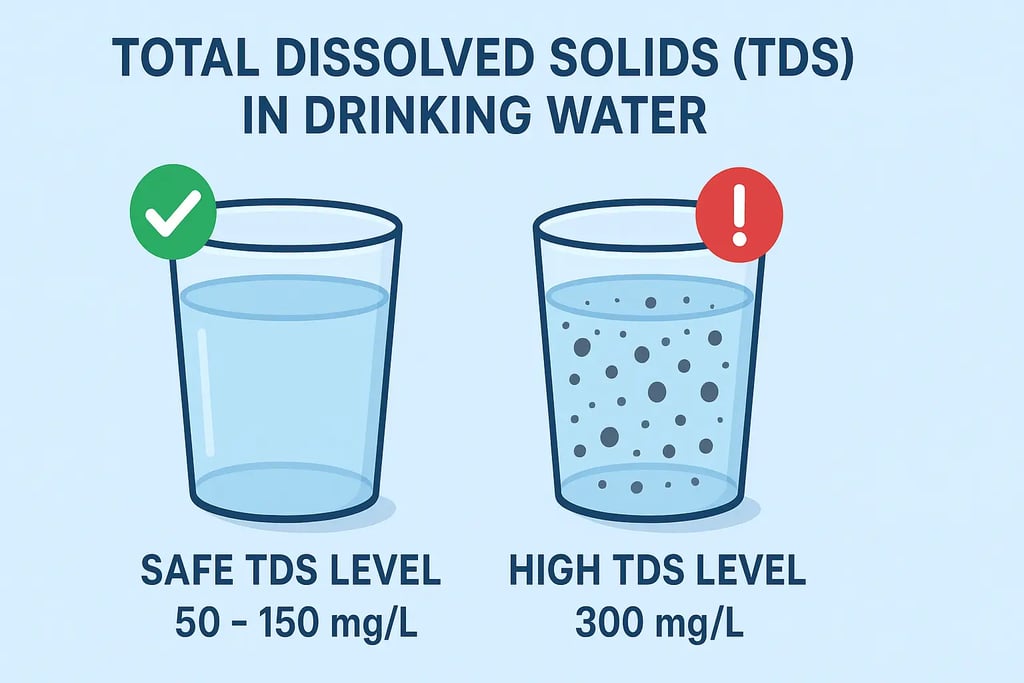Total Dissolved Solids (TDS): Meaning, Safe Levels & Reduction Tips
Learn what Total Dissolved Solids (TDS) are, why TDS levels matter in drinking water, the health risks of high TDS, and effective ways to reduce TDS for better water quality and appliance performance.


Understanding Total Dissolved Solids (TDS) in Drinking Water
What Is TDS?
Total Dissolved Solids (TDS) refer to the combined concentration of organic and inorganic substances present in water. These include minerals (like calcium and magnesium), salts (such as sodium chloride), and metals (like iron and lead). TDS can come from both natural sources—like soil and rock erosion—and human activities, including industrial discharge, agricultural runoff, and municipal water treatment processes.
TDS is a key parameter for evaluating water quality, as it directly affects both human health and the efficiency of home appliances. High TDS can influence the taste, odor, and safety of drinking water.
Ideal TDS Levels in Drinking Water
TDS levels are measured in milligrams per liter (mg/L) or parts per million (ppm). The classification generally follows:
Low TDS: 0–300 mg/L (Excellent)
Acceptable TDS: 300–600 mg/L (Good)
High TDS: Above 600 mg/L (Poor)
According to health experts, drinking water is safest when TDS levels are below 500 mg/L. However, this can vary depending on your geographic region and the source of water—such as groundwater, surface water, or municipal supply. Monitoring local water quality helps ensure that the TDS levels remain within acceptable limits.
Why Monitoring TDS Is Important
High TDS not only affects taste and odor but also indicates potential contaminants that can harm health or damage plumbing systems. Excessive dissolved solids can suggest the presence of heavy metals or pollutants, making regular water testing essential. Keeping TDS within a safe range ensures clean drinking water and protects both health and household infrastructure.
Health Risks of High TDS in Water
Drinking water with high TDS levels can pose several health risks due to the presence of inorganic salts, heavy metals, and organic compounds. These can alter hydration balance and negatively impact overall wellness.
1. Dehydration and Kidney Issues
High TDS water can make it harder for the body to absorb fluids efficiently, leading to dehydration. Over time, this can increase the risk of kidney stones, fatigue, and heat exhaustion.
2. Digestive and Nutrient Absorption Problems
Excess minerals and salts in water may disrupt the body’s nutrient absorption process, resulting in stomach discomfort, indigestion, and loss of appetite.
3. Heavy Metal Toxicity
Untreated water with high TDS may contain toxic metals such as lead, arsenic, and mercury, which can cause neurological damage, developmental issues in children, and organ dysfunction over prolonged exposure.
4. Vulnerable Groups
Children and the elderly are particularly susceptible to the effects of contaminated water. Children may experience allergic reactions or stomach cramps, while elderly individuals with weaker immune systems face a higher risk of waterborne illnesses.
💧 Tip: If you frequently experience symptoms like unusual fatigue, digestive issues, or dryness, consider testing your home water for TDS levels.
Impact of High TDS on Home Appliances
Apart from health concerns, high TDS levels can severely affect water-based appliances such as dishwashers, washing machines, and water heaters.
1. Scale Buildup
Minerals like calcium and magnesium form scale deposits inside appliances. This buildup can clog filters, reduce heating efficiency, and increase energy usage—leading to higher electricity bills and shortened appliance lifespan.
2. Reduced Cleaning Efficiency
In laundry machines, high TDS water can interfere with detergent effectiveness, causing stiff fabrics and residue on clothes. Similarly, dishwashers may produce spotty dishes or dull glassware.
3. Plumbing Damage
Over time, dissolved solids accumulate in pipes and fittings, causing blockages and corrosion that require frequent repairs.
✅ Preventive Tip: Use water softeners or reverse osmosis systems to control TDS and protect household appliances.
How to Reduce and Manage High TDS Levels
Reducing Total Dissolved Solids in household water involves selecting the right purification system and maintaining it regularly. Below are the most effective methods:
1. Reverse Osmosis (RO) Filtration
RO systems are the most efficient at lowering TDS levels. Water passes through a semi-permeable membrane, removing salts, metals, and other impurities. Although RO systems can be more expensive, they provide excellent purification for drinking water.
2. Carbon and Sediment Filters
Activated carbon filters can remove chlorine, bad odor, and organic contaminants, improving taste and appearance. However, they may not significantly reduce inorganic TDS, making them ideal as a pre-treatment stage with RO systems.
3. Water Softeners
For homes with hard water, water softeners replace calcium and magnesium ions with sodium ions, reducing hardness and preventing scale buildup in appliances.
4. Regular Testing and Maintenance
Conduct water quality tests every 3–6 months to monitor TDS levels and ensure treatment systems are functioning properly. Timely filter replacements and routine servicing help maintain safe, clean water year-round.
Conclusion
Monitoring and managing Total Dissolved Solids (TDS) in your drinking water is crucial for maintaining good health, appliance efficiency, and overall water safety. High TDS can affect everything—from your body’s hydration to the performance of your home appliances. By investing in reliable filtration methods and regular testing, you can ensure your family enjoys pure, healthy, and refreshing water every day.
